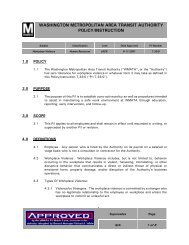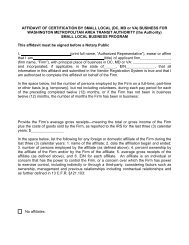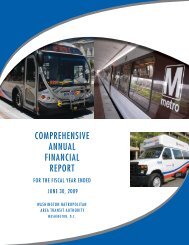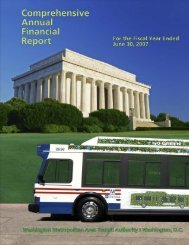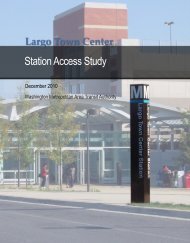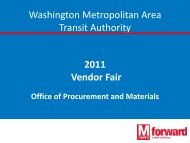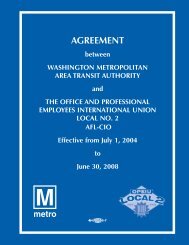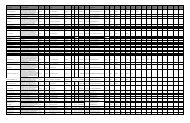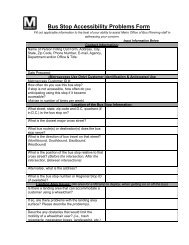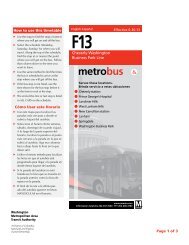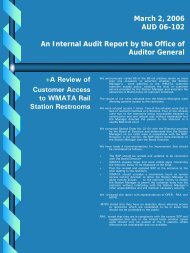Naylor Road Metro Station Area Access and Capacity - WMATA.com.
Naylor Road Metro Station Area Access and Capacity - WMATA.com.
Naylor Road Metro Station Area Access and Capacity - WMATA.com.
You also want an ePaper? Increase the reach of your titles
YUMPU automatically turns print PDFs into web optimized ePapers that Google loves.
Specific implementation timelines are not defined in this study. However, TOD-based<br />
re<strong>com</strong>mendations rely on the implementation of the mixed-use vision for the station <strong>and</strong><br />
are therefore generally considered long-term re<strong>com</strong>mendations. Existing station area<br />
re<strong>com</strong>mendations, on the other h<strong>and</strong>, are not dependent upon TOD <strong>and</strong> can thus be<br />
implemented at any point in the near term or long term. Implementing many of the station area<br />
re<strong>com</strong>mendations will involve coordination between <strong>Metro</strong> <strong>and</strong> various local, regional, <strong>and</strong><br />
federal agencies, private developers, <strong>and</strong> members of the <strong>com</strong>munity. Re<strong>com</strong>mendations are not<br />
constrained by implementation costs.<br />
Existing <strong>Station</strong> <strong>Area</strong> Re<strong>com</strong>mendations<br />
Existing station area re<strong>com</strong>mendations, shown in Table 24, were devised in response to observed<br />
deficiencies that result from the present configuration of <strong>Naylor</strong> <strong>Road</strong> <strong>Station</strong>’s facilities <strong>and</strong><br />
the existing conditions of its surroundings. A few of these re<strong>com</strong>mendations will remain<br />
relevant only until the station area is redeveloped, at which point the existing facilities will be<br />
removed <strong>and</strong> reconfigured. Most existing station area re<strong>com</strong>mendations will stay relevant after<br />
station area redevelopment because the need will remain after the introduction of TOD or they<br />
address a nearby need beyond <strong>Metro</strong> property. Existing station area re<strong>com</strong>mendations can be<br />
implemented independently of each other, but some re<strong>com</strong>mendations may be more effective if<br />
implemented in concert.<br />
Pedestrian <strong>and</strong> Bicycle<br />
Improving the <strong>Naylor</strong> <strong>Road</strong> <strong>Station</strong> area’s walking <strong>and</strong> cycling environment is a critical step<br />
toward realizing its mixed-use, transit-oriented vision. Many of the station area’s pedestrian<br />
<strong>and</strong> bicycle deficiencies can be addressed before TOD is implemented. This study’s existing<br />
station area pedestrian <strong>and</strong> bicycle re<strong>com</strong>mendations (Table 25) are designed to improve safety,<br />
convenience, <strong>and</strong> accessibility. These re<strong>com</strong>mendations, which are mapped in Figure 47, are<br />
the result of station observations performed during this study as well as findings presented in<br />
previously <strong>com</strong>pleted <strong>and</strong> ongoing station area improvement plans.<br />
As noted in Table 25, some of these re<strong>com</strong>mendations require more detailed operational <strong>and</strong><br />
safety analyses to conclude overall feasibility. Implementing any of these re<strong>com</strong>mendations will<br />
require coordination between <strong>Metro</strong> <strong>and</strong> local, regional, <strong>and</strong> federal partners, including NPS,<br />
Maryl<strong>and</strong> Department of Transportation (MDOT), SHA, M-NCPPC, Prince George’s County<br />
Department of Public Works <strong>and</strong> Transportation (DPW&T), <strong>and</strong> DDOT.<br />
For example, re<strong>com</strong>mendations 1, 2, 4, 5, 9, 10, <strong>and</strong> 12 in Table 25 highlight improvements<br />
proposed by the SHA Streetscape Project—currently in the design phase <strong>and</strong> planned to begin<br />
construction in 2014, if funding is identified—<strong>and</strong> supported by foundation laid by the Branch<br />
Avenue Corridor Sector Plan. The SHA Streetscape Project is expected to improve crossing<br />
safety, widen or add sidewalks to a 6.5- to 10-foot width, <strong>and</strong> add bicycle facilities on <strong>Naylor</strong><br />
<strong>Road</strong> south of Suitl<strong>and</strong> Parkway <strong>and</strong> on Branch Avenue south of the <strong>Naylor</strong> <strong>Road</strong> <strong>Station</strong> access<br />
point (see Figure 48 for proposed cross sections). The SHA Streetscape Project also plans to<br />
improve access along observed pedestrian desire lines with a ramp <strong>and</strong> sidewalk on <strong>Naylor</strong><br />
<strong>Road</strong> at the northwest corner of the Park & Ride, <strong>and</strong> sidewalks on both sides of the Park & Ride<br />
entryway between the roundabout <strong>and</strong> the Park & Ride payment booths.<br />
<strong>Naylor</strong> <strong>Road</strong> <strong>Metro</strong> <strong>Station</strong> <strong>Area</strong> <strong>Access</strong> <strong>and</strong> <strong>Capacity</strong> Study | 52





